The Kinloch Telephone Company
The Early Years
The Kinloch Telephone Company was organized in 1896. At the turn of the century, St. Louis was the fourth largest city in the United States (ranked behind New York City, Chicago, and Philadelphia), earning it the nickname the “Fourth City.” St. Louis was heralded as a center for invention, innovation, and abundant economic development.
In September 1896, St. Louis adopted a new city ordinance regulating the construction and operation of underground conduits and other telephone equipment. Businessmen wasted no time, and just three months later on December 5th, 1896, the Kinloch Telephone Company came to be. One of the first meetings was held at the Kinloch Club in Florissant, Missouri which inspired the name of the company. At the time, the Kinloch Telephone Company was the largest of the “Independent Telephone Companies,” a name used to refer to those companies that were entirely independent from the Bell Telephone system.
The telephone was a rapidly expanding industry, and there was a general fascination with the opportunities that a telephone could provide.
The advent of an instrument by which speech is transmitted with a velocity of light, and all inflections of the human voice preserved, bears a significance to the material business and social prosperity of the people which stands unprecedented in the annals of human inventions. A means of communication destined to revolutionize business methods, bring us face to face, though separated by thousands of miles, is that delicate piece of mechanism first presented to the public a little over two decades ago, the “telephone.”
Construction was vast and rapid. From March to July 1897, underground conduit was laid throughout the city. At a time when business conditions were relatively depressed, men were eager for work. Workers were paid $1.25 for a ten hour day (roughly the equivalent of $3.50/hour in 2015).
To encourage potential subscribers to adopt their service, the Kinloch Telephone Company offered service to their customers free of charge until they reached a number of 4,000 total subscribers. Thereafter, annual rates were fixed at $60 for businesses, $50 for physicians, and $36 for residences.
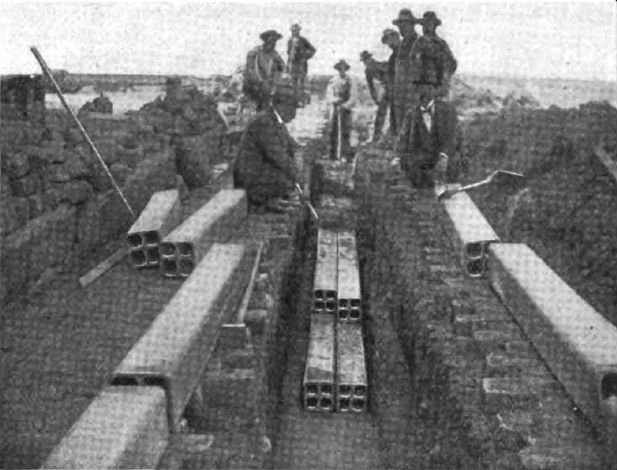
Method of Laying Conduit. Ref. #A4.
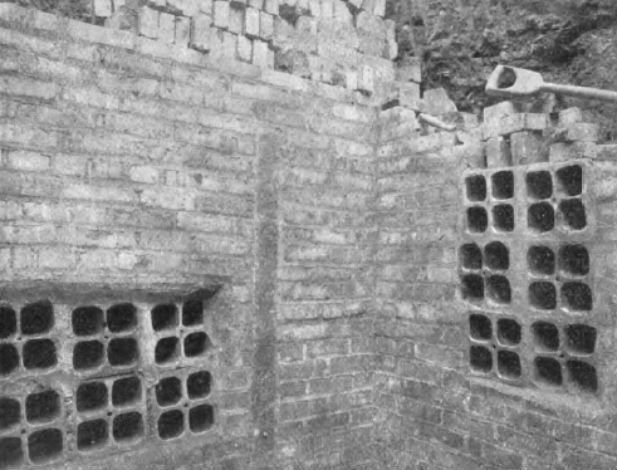
Manhole in Construction Showing Different Groupings of Vitrified Conduit. Ref. #A4.
ST. LOUIS STREET SCENES IN THE EARLY 1900's SHOWING TELEPHONE LINES AND POLES

Photo Source: Missouri History Museum
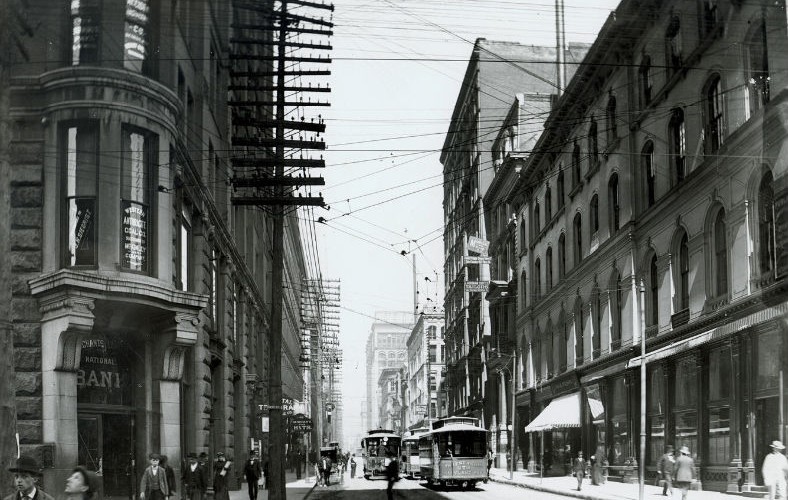
Photo Source: Missouri History Museum
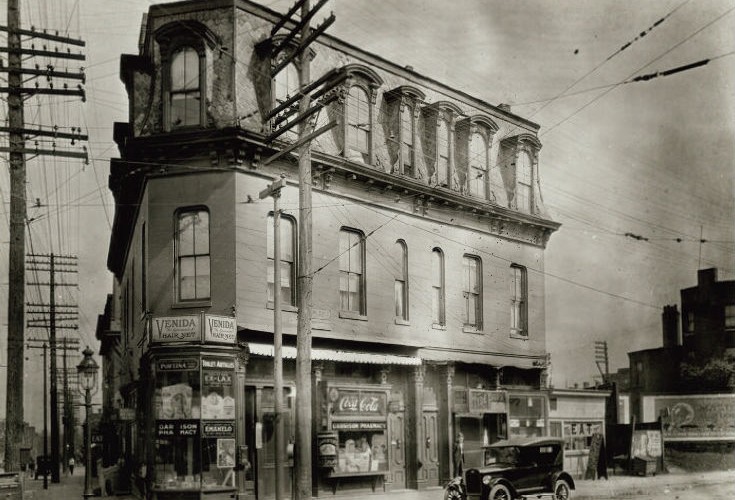
Photo Source: Missouri History Museum
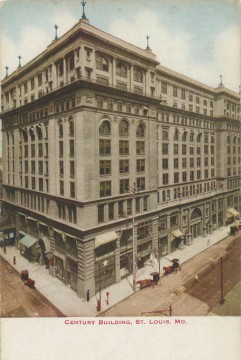 Operations of the company were based out of the tenth floor of the Century Building, which served as their “Central Exchange” from 1897 until 1905. The Century building, demolished in 2004, occupied part of the city block at 9th Street between Olive and Locust Streets. Today, that location is occupied by Schnucks Culinaria and a parking garage.
Operations of the company were based out of the tenth floor of the Century Building, which served as their “Central Exchange” from 1897 until 1905. The Century building, demolished in 2004, occupied part of the city block at 9th Street between Olive and Locust Streets. Today, that location is occupied by Schnucks Culinaria and a parking garage.
The Kinloch Telephone Company utilized a state-of-the-art Kellogg switchboard. The capacity of the switchboard was an impressive 6,160 lines at its installation in 1897. By 1898, an extension was added to increase the total lines to 8,800.
Photo Credit: Ref. #D1.
The lines were operated by “telephone girls” or “hello girls” who would patch calls through from subscribers. To work at a Kinloch or Bell telephone exchange, girls needed to have excellent eyesight, clear speech, and meet an unusual height requirement of 5’4″. Exceptions could be made for a girl who did not meet the height requirement, “provided, of course, that she is bright” (The Cradle and Grave of the St. Louis Telephone Girl, 1902, Ref. #C1).
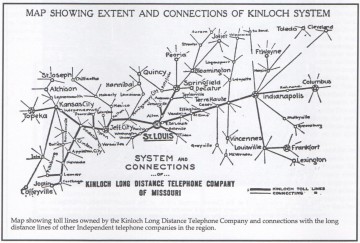 On June 12, 1900, the Kinloch Long Distance Telephone Company was organized. While separate from the local Kinloch Telephone Company, the Kinloch Long Distance Telephone Company expanded telephone service for the Kinloch lines into the neighboring states of Kansas, Illinois, and Indiana.
On June 12, 1900, the Kinloch Long Distance Telephone Company was organized. While separate from the local Kinloch Telephone Company, the Kinloch Long Distance Telephone Company expanded telephone service for the Kinloch lines into the neighboring states of Kansas, Illinois, and Indiana.
Photo Credit: Ref. #A1.
The Kinloch Telephone Exchanges
The Kinloch Telephone Company continued to exhibit a great amount of economic success and progress over the next few years, giving rise to the need for additional exchange buildings.
“Delmar” Exchange
The first exchange to be constructed was the “Delmar” exchange, located at 4400 Delmar Boulevard. This building was completed in late 1902, just in time for the World’s Fair. The exchange featured a capacity of 7,200 lines and a 22-volt common battery switchboard.
The extant Delmar exchange now operates as a local church, located at 4400 Delmar Blvd. Other than the addition of some white paint, the building looks much the same today as it did over 100 years ago.
Below: Photos of the Delmar exchange in 1904 (Ref. #A3) and 2015.
“Saint Clair” Exchange
Shortly after the Delmar exchange was completed, another exchange was commissioned. This exchange was to be located in East St. Louis at the intersection of 5th and Missouri Avenues. Completed in 1903, the “Saint Clair” exchange building had a capacity of 5,000 lines and a 44-bolt common battery switchboard.
The Saint Clair exchange has since been demolished, likely some time in the 1990’s, and is now the site of the 5th and Missouri MetroLink light rail station.
“Victor” Exchange
In June 1903, a third exchange was approved. Located at the intersection of Indiana and Ann Avenues in South City, the “Victor” exchange was completed in 1904. This location had a capacity of 7,200 lines and a 44-volt common battery switchboard.
The Victor exchange was purchased by South Side Spaces in 2013.
World’s Fair Exchange at the Palace of Electricity
The Kinloch Telephone Company also created an exchange at the St. Louis World’s Fair in 1904. While this exchange was ultimately a temporary installation, it was a noteworthy achievement, and Kinloch was able to provide telephone service to World’s Fair visitors through the use of a Kellogg switchboard in the Palace of Electricity. The Bell Telephone Company also had an exhibit in the same building. The Kinloch service was conducted by sixteen onsite operators, and the exhibit was a demonstration of the powerful St. Louis telephone system.
The value of rapid and easy communication is so fully appreciated that the telegraph and telephone lines precede the army, the railroad, and even the builder… The central stations and most of the apparatus are located in the Electricity Building, where the exhibit and commercial features can be combined to best advantage. Telephones are freely distributed for use of both exhibitors and the public, and, by means of the connection through the St. Louis exchanges, one can converse from one exhibit to another, to any building on the Fair Grounds, to any place in the city or as far east as the Atlantic and west to the Rocky Mountains.
Electrical World and Engineer, July 9, 1904. Ref. #A5.
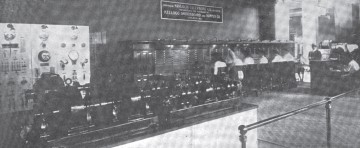
Kinloch switchboard at the World’s Fair, inside the Palace of Electricity. Ref. #A4.
A New Central Exchange
On February 2, 1904, a new Central exchange was suggested. By May, the Kinloch Telephone Company had acquired a site at the northwest corner of 10th and Locust Streets for the proposed six-story building.
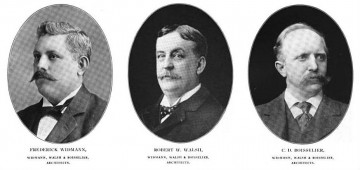 The new Kinloch Building was designed by local architectural firm Widmann, Walsh, and Boisselier. This mustachioed trio was well known throughout the United States and internationally for their brewery buildings. Most notably in St. Louis, Widmann, Walsh, and Boisselier designed all of the buildings for the Anheuser Busch Brewing Association in the early 20th century.
The new Kinloch Building was designed by local architectural firm Widmann, Walsh, and Boisselier. This mustachioed trio was well known throughout the United States and internationally for their brewery buildings. Most notably in St. Louis, Widmann, Walsh, and Boisselier designed all of the buildings for the Anheuser Busch Brewing Association in the early 20th century.
Other accomplishments included the Palace of Machinery in the St. Louis World’s Fair in 1904, and a few residential homes in the Westmoreland and Portland Place neighborhoods.
Photo Credit (above): Ref. #A13.
Photo Credit (below): Missouri History Museum.
Construction took place over the next year and was completed in 1905. The Kinloch Telephone Company now faced the daunting task of transitioning their lines and service out of the Century Building and into the new Kinloch Building. Somewhat miraculously, this highly orchestrated maneuver was completed overnight and took all of ten minutes. Following this seamless transition, the new switchboard was cut into service the following morning on September 24, 1906.
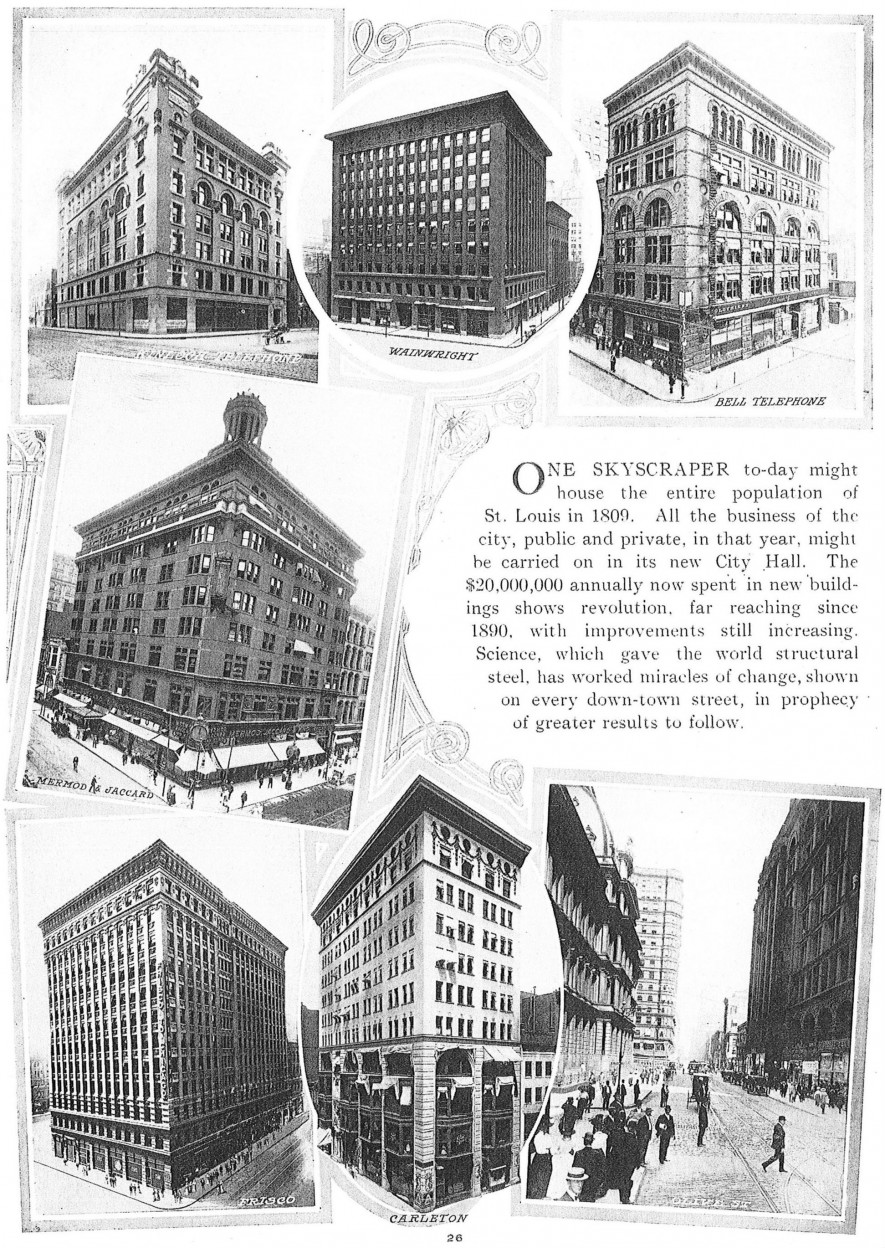
Photo: Advertisement showing skyscrapers in downtown St. Louis. The Kinloch Telephone Building is shown at the upper left. Ref. #A11.
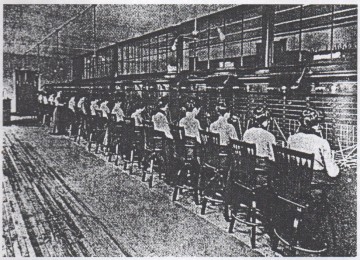 This switchboard had a capacity of up to 18,000 lines (compared to 8,800 lines at their previous Century Building headquarters) and for many years was not only the largest switchboard in the United States, but the largest switchboard in the world.
This switchboard had a capacity of up to 18,000 lines (compared to 8,800 lines at their previous Century Building headquarters) and for many years was not only the largest switchboard in the United States, but the largest switchboard in the world.
Photo Credit: Ref. #A11.
Consolidation of the Various Kinloch Companies
The fast paced growth of the Kinloch Telephone Company continued along its trajectory before and after the completion of the new Central Exchange. By the end of 1905, the Kinloch Telephone Company had merged with the Kinloch Long Distance Company. They also acquired local competitors, the Suburban Telephone Company and the Sedalia Telephone Company. Under the new parent company of the Kinloch Long Distance Telephone Company, the Kinloch system now had 14 exchange buildings.
The Later Years and the Merger with Bell Telephone Company
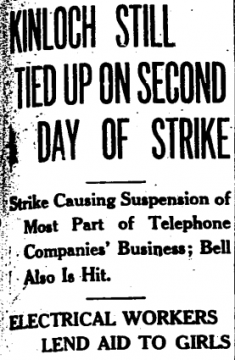 The next two decades were not nearly as prosperous for the Kinloch Long Distance Telephone Company. Economic depression in St. Louis in 1907 and 1908 halted construction of any additional buildings. The Kinloch Telephone Company was forced to re-evaulate their finances and set aside additional money for depreciation in subsequent years.
The next two decades were not nearly as prosperous for the Kinloch Long Distance Telephone Company. Economic depression in St. Louis in 1907 and 1908 halted construction of any additional buildings. The Kinloch Telephone Company was forced to re-evaulate their finances and set aside additional money for depreciation in subsequent years.
Photo Credit: Ref. #C3.
Economic activity in St. Louis was also affected by World War I. High levels of government control and low funds led to little development, although Kinloch continued to improve its long distance service and quality of transmission. From 1919 to 1921, a series of strikes by “telephone girls” and other employees of the Kinloch Telephone Company caused disturbances to development and resulted in economic loss.
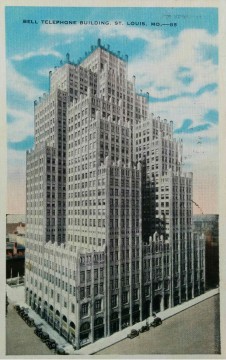 In 1923, the Kinloch Long Distance Telephone Company was purchased by the Southwestern Bell Telephone Company (previously named the Bell Telephone Company prior to a name change in 1917) under their name. At the time of the merger, Kinloch had around 50,000 phones (or “stations”) and Southwestern Bell had 120,000. The consolidation was generally good for subscribers of both companies, who previously had to have phones of each the Kinloch and Bell varieties if they wished to make calls to individuals who had only one or the other type of service.
In 1923, the Kinloch Long Distance Telephone Company was purchased by the Southwestern Bell Telephone Company (previously named the Bell Telephone Company prior to a name change in 1917) under their name. At the time of the merger, Kinloch had around 50,000 phones (or “stations”) and Southwestern Bell had 120,000. The consolidation was generally good for subscribers of both companies, who previously had to have phones of each the Kinloch and Bell varieties if they wished to make calls to individuals who had only one or the other type of service.
Photo Credit: Ref. #D2.
Prior to the organization of the Kinloch Telephone Company in 1896, Bell Telephone had 3,800 phones in the city of St. Louis. By the time of the merger just 27 years later, there were 170,000 phones between the two companies – nearly 45 times as many. The telephone turned “a nation into a neighborhood”:
Time and space are as nothing. Sound itself is a tortoise in comparison with the swift currents which bear the voice, the spirit, the emotions, a few hundred yards or thousands of miles in a flash. From Bell’s single telephone of 1876 has grown up a nation-wide system of 16,000,000 telephones.
A Monument to Communication, 1926. (Ref. #A12)
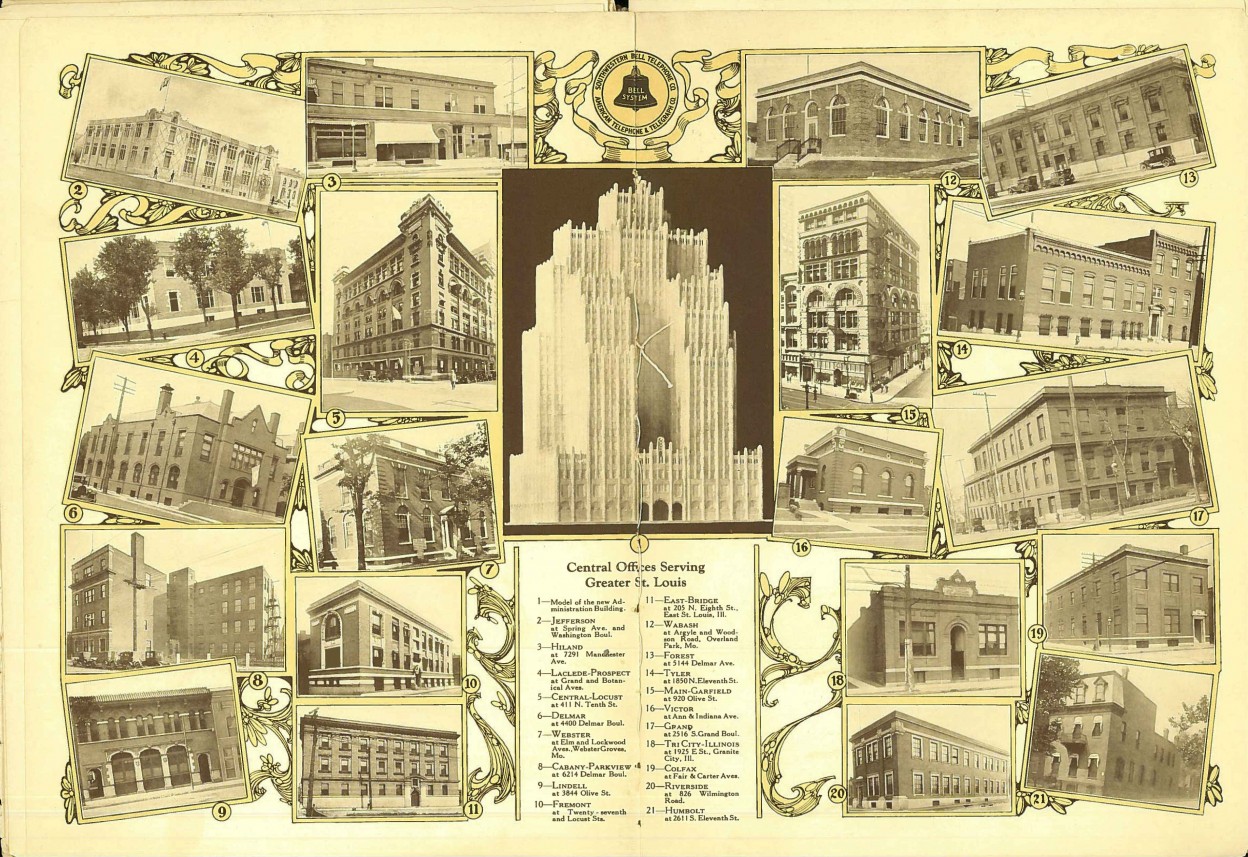
Photo: Central offices of the Southwestern Bell Telephone Company (1926). The former Kinloch Central Exchange is shown (#5), as well as the Delmar Exchange (#6) and the Victor Exchange (#16). Ref. #A12.
Following the merger, the name Kinloch all but died out. Most people today know little about the Kinloch Telephone Company, even though Kinloch’s former Central Exchange is hiding in plain sight in downtown St. Louis. As a result of the modernizing “face lift” that the building received in 1954, the structure is barely recognizable from its original appearance.
The modernization of historic buildings was a common trend in St. Louis from the 1930’s through the 1950’s; most new construction in the downtown area did not occur until the 1960’s. This movement to revitalize outdated and vacant buildings followed several decades of population and economic decline in the city. While the needs of business were changing and the desire for new growth was strong, the “waste not” attitude following World War II and the Great Depression resulted in more alterations than additions.
Buildings were modernized by one of two methods: they were either “skinned”, which involved chipping away the ornamental details and re-surfacing the exterior, or they were “sheathed” or “curtained” by essentially hanging a curtain over the top of the original facade. While the former method is largely irreparable, some sheathed buildings in St. Louis have been restored. Sadly, the Kinloch Building was skinned, and restoring the building to its ornate 1905 condition is next to impossible.
Other Kinloch buildings faced worse fates, as the Saint Clair exchange was demolished in the 1990’s, and the Century Building was demolished in 2004. Today, just the Delmar exchange and the Victor exchange exist as testaments to Kinloch’s previous legacy in the city of St. Louis.
